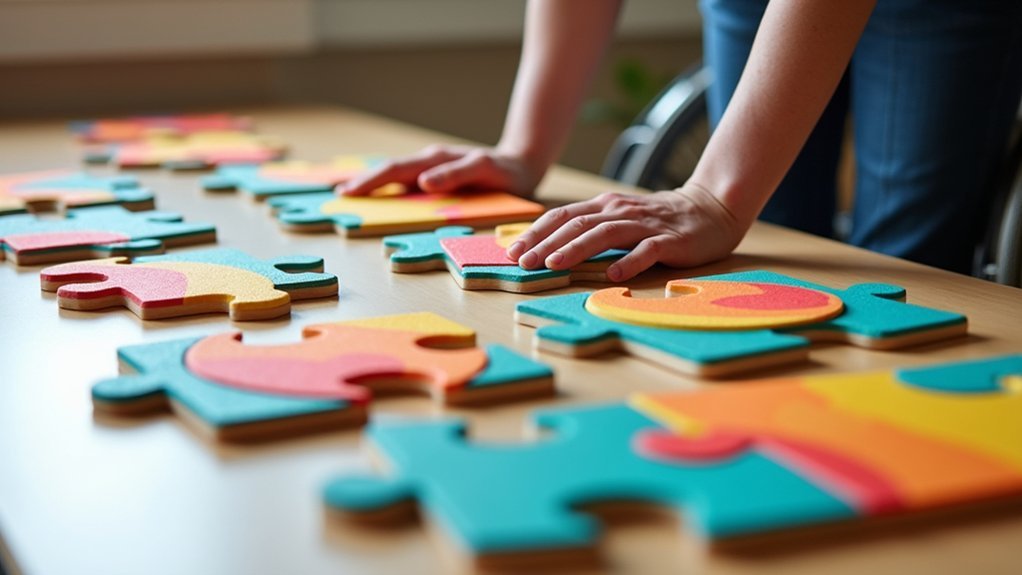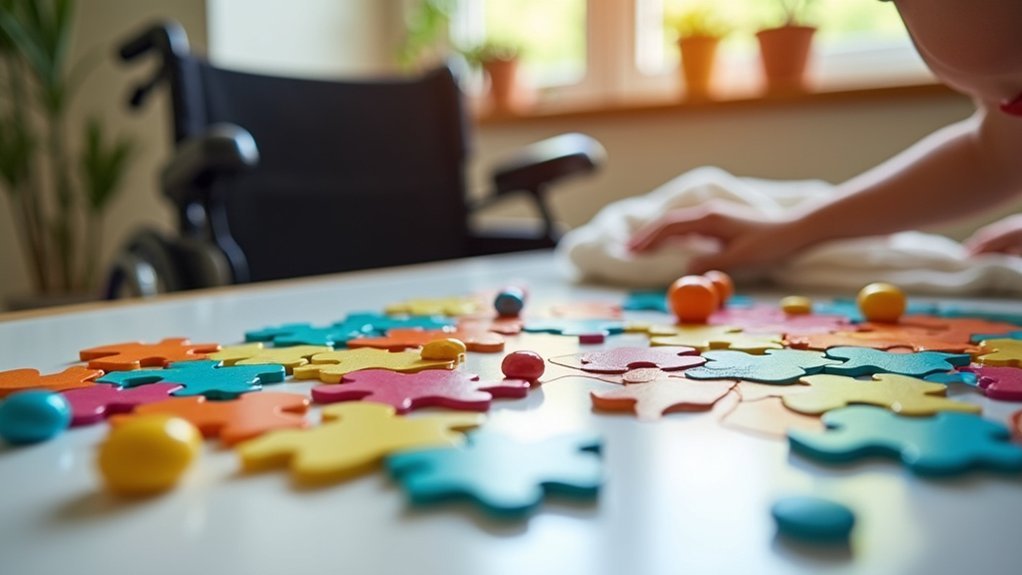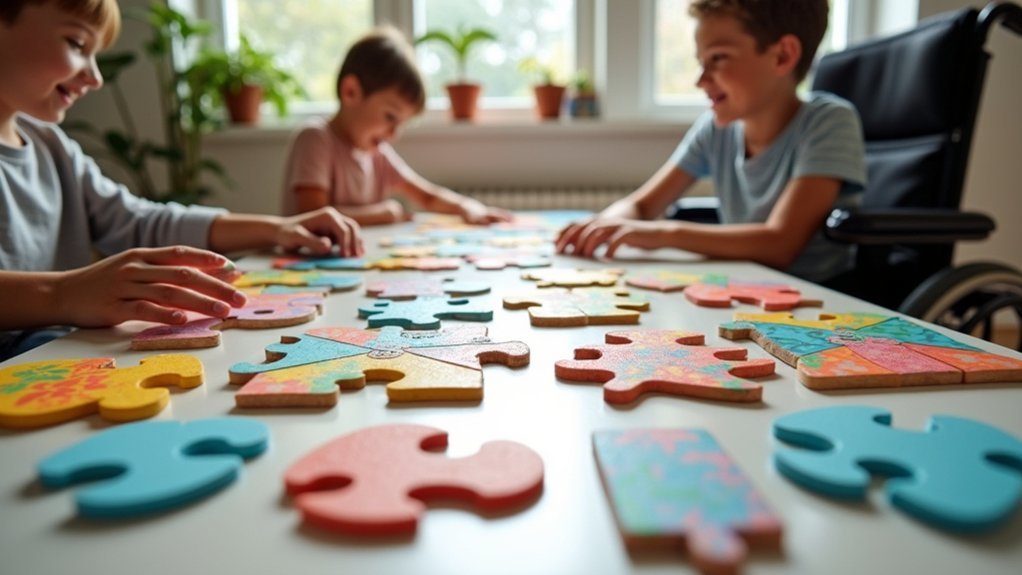Wheelchair users benefit most from puzzles with large, easy-grip pieces that have ergonomic shapes or special coatings. Look for options with high-contrast designs and magnetic or interlocking components to prevent shifting during play. Height-adjustable tables or puzzle mats can create a comfortable setup. Digital puzzle apps offer excellent alternatives with customizable interfaces and accessibility features. Beyond entertainment, these accessible puzzles provide therapeutic benefits for cognitive health and stress reduction. The right puzzle adaptations make all the difference.
Ergonomic Puzzles With Accessible Design Features

While traditional puzzles often present physical challenges for wheelchair users, ergonomically designed puzzles are transforming this beloved pastime into an accessible activity for everyone.
You’ll find puzzles with easy-grip pieces that feature special coatings or ergonomic shapes, making them easier to grasp and manipulate.
Look for options with high visual contrast and clear designs to accommodate visual impairments. Many accessible puzzles now include tactile markers that provide sensory feedback for better piece identification.
Consider puzzles that come in various sizes to match your dexterity level. Larger pieces work well if you have limited hand mobility, while smaller options offer greater challenge as abilities improve.
Durable, easy-to-clean materials guarantee your puzzle investment lasts through repeated use and occasional spills. Specialized puzzle tables with adjustable heights and tilt features allow wheelchair users to enjoy puzzles without leaning forward uncomfortably.
Digital and Tech-Enhanced Puzzle Solutions
Beyond ergonomic physical puzzles, technology has revolutionized accessibility for wheelchair users who enjoy puzzles. You’ll find apps like Vita Jigsaw with large buttons and oversized pieces designed specifically for limited dexterity.
Most digital puzzle apps support screen readers, magnification features, and adjustable difficulty levels to match your abilities. Snap-to-fit mechanics and touch interaction replace manual manipulation, reducing physical strain if you have motor challenges.
Digital puzzles transform accessibility through adaptive features, eliminating physical barriers while maintaining the joy of problem-solving.
Apps like “See Me Draw” accommodate single-limb use with bold graphics and intuitive interfaces. Many include audio cues and engaging sounds for a multisensory experience. Puzzle enthusiasts can also find options like Blindfold Sudoku that offers full keyboard access and audio play functionality.
The best part? Most are free or low-cost on iOS and Android platforms. You can even explore hybrid options that pair physical puzzles with companion apps for enhanced engagement and accessibility.
Therapeutic Benefits of Puzzle-Solving for Wheelchair Users

Puzzle solving offers remarkable therapeutic benefits for wheelchair users that extend far beyond simple entertainment.
When you engage with puzzles, you’re actively reducing stress levels while giving your brain a thorough workout that improves memory and concentration. The stress relief is particularly valuable as puzzles provide stress relief benefits comparable to meditation.
You’ll experience mood enhancement and increased self-esteem with each completed puzzle, providing a valuable sense of control and accomplishment. This is particularly significant if you deal with chronic pain, as puzzles offer therapeutic distraction and mental escapism.
The neuroprotective effects of regular puzzle-solving may help delay cognitive decline, while simultaneously improving brain plasticity and problem-solving skills.
When combined with adaptive tools and ergonomic puzzle boards designed for seated access, you’re not just enjoying a hobby—you’re participating in an activity that supports your cognitive and emotional wellbeing.
Tabletop Puzzles With Wheelchair-Friendly Setup Options
Turning cognitive benefits into practical play, tabletop puzzles can be readily adapted with wheelchair-friendly setups that remove physical barriers.
Height-adjustable or tilting tables guarantee you’ll find comfortable positioning without straining to reach pieces.
Consider puzzles with high-contrast colors and tactile elements that enhance recognition through both sight and touch. Sharp contrast between puzzle pieces makes identification easier for players with low vision. Non-slip puzzle mats prevent frustrating piece movement during play.
For maximum accessibility, create an open layout with ample space for maneuverability around centralized play areas.
Technology offers additional options—digital platforms with text-to-speech features or apps with audio cues accommodate various abilities. Voice-controlled assistants can help you manage components without physical manipulation.
When setting up puzzle sessions, remember that customizable components and clutter-free environments maximize your independence and enjoyment.
Adaptive Puzzle Modifications and Customization Approaches

While standard puzzles may present challenges for wheelchair users, adaptive modifications can transform these activities into fully accessible experiences.
Large piece puzzles with knob handles offer easier grip and manipulation, reducing fine motor challenges. Magnetic components keep pieces secure, preventing frustration from accidental movement.
You’ll find that switch activation systems open possibilities for those with limited mobility, while textured surfaces enhance sensory engagement.
Consider puzzles with variable difficulty levels to match your specific cognitive preferences.
For digital options, look for touchscreen compatibility and adaptable controls that you can customize to your needs.
Many digital puzzles now include audio feedback and large display options for improved accessibility.
Don’t hesitate to explore DIY modifications or participate in community workshops where you can help design puzzles that work perfectly for you.
Frequently Asked Questions
How Do I Find Puzzles Specifically Designed for One-Handed Users?
To find puzzles for one-handed users, you’ll discover options through online accessibility blogs, inclusive toy stores, design communities, adaptive recreation centers, or by commissioning custom puzzle makers who specialize in adaptive solutions.
Are There Puzzle Communities That Welcome and Support Wheelchair Users?
You’ll find many puzzle communities that welcome wheelchair users. Look for venues with accessibility features, adaptive puzzle designs, and inclusivity-focused groups like those hosting events at community centers and senior living facilities.
What Puzzle Types Help Manage Anxiety While in Medical Settings?
In medical settings, you’ll find tablet-based visual puzzles, digital jigsaws, and tactile puzzles particularly effective for anxiety management. They provide cognitive distraction, promote focus, and create a sense of control during stressful procedures.
How Does Puzzle Difficulty Progression Work for Developing Capabilities?
You’ll start with simple matching puzzles, then gradually increase complexity as your skills develop. You’ll progress through greater piece counts, reduced physical aids, and eventually tackle multidimensional problems that build real-life problem-solving abilities.
Can Puzzle Therapy Be Covered by Insurance or Disability Services?
Yes, you may get insurance coverage for puzzle therapy if it’s medically necessary, especially for autism treatment. Check with your provider and explore disability services that might cover therapeutic interventions as part of broader treatment plans.
In Summary
You’ll find the best puzzles for your needs by focusing on what works with your specific mobility and setup. Whether you’re choosing ergonomic designs, digital options, or modified tabletop puzzles, the right match enhances both enjoyment and therapeutic benefits. Don’t hesitate to customize existing puzzles or explore adaptive solutions—your perfect puzzle experience is about finding what fits your unique situation and preferences.





Leave a Reply